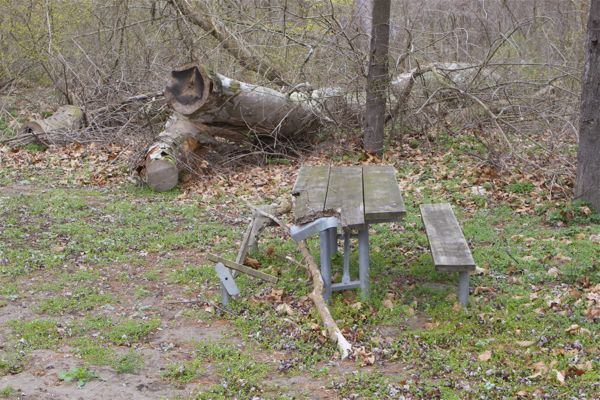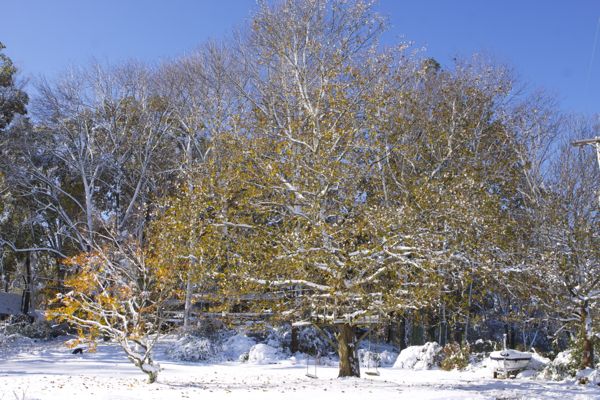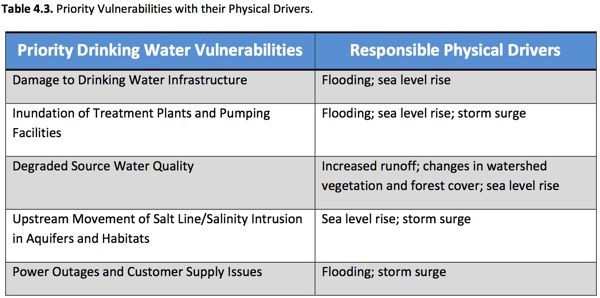Poor Risk Management – Not Greedy Trial Lawyers – At Fault

campsite at Bull's Island where camper was killed in June 2011. State lawyers required the tree to remain. It serves as a good prop for DEP PR flacks to use as a photo op and to scare people.
Star Ledger conservative columnist Paul Mulshine weighs in today on the Bull’s Island clearcut debate, see: You can’t see the forest for the lawyers.
While I rarely agree with him on political and policy issues, I like Mulshine as a person and an edgy columnist. We bushwhacked into the “closed” Bull’s Island park a few weeks ago and had a beer afterwards. His column raises many legitimate issues and will help get word out on DEP’s insane “War on Killer trees“.
Mulshine starts off on the right track, but is soon derailed:
Let me first state that I agree with environmental activist Bill Wolfe when he argues that the state Department of Environmental Protection should drop its plans to cut down all those graceful old sycamores at Bull’s Island Recreation Area.
Mulshine’s argument is derailed for three basic reasons:
1) he views the issue through the liability lens and his animus to trial lawyers – the headline to his column reveals this bias, which is red meat to his conservative readers.
I had hoped he’d frame this liability issue as one of risk management and individual freedom – what the conservatives call “the tyranny of the nanny state” (an argument that has some merit and with which I share some agreement.)
Had he gone down that principled conservative libertarian road and framed the issue correctly, the argument would not support his conclusion in support of DEP’s clearcut.
2) He was spun by DEP foresters on tree health and liability; and
3) he misapplied the case of the recent death in south jersey of 2 young boys killed by a fallen tree while camping at Parvin State park.
The Parvin deaths are completely different than Bull’s Island situation, both legally and ecologically.
So, here’s why Mulshine’s premises, analysis, and conclusions are wrong (and he totally misunderstood my allusion to sycamores as “the redwoods of the east”, which was metaphorical, not literal (as John Prine says “You know Old Trees just grow stronger“.) It was metaphorical in the sense that these are huge, special old trees that are well recognized and loved, evocative of and defining the character of northeast river fronts, to a very similar degree that the Redwood symbolizes northern California. I thought Mulshine – as a literate man – was able to handle that kind of nuanced complexity – but I guess not because he used it in a literal way as his “gotcha” quote – posed contra to a DEP forester and as the fulcrum of his argument. Makes one want to puke).
I) Risk Management
1) Risks of trees falling
Mulshine is sympathetic to the DEP arguments about State liability due to falling trees that kill campers.
But he left out a key fact that totally destroys DEP’s argument for cutting the trees.
DEP has permanently closed the northern Island to camping.
Therefore, there is no risk of campers being killed by a falling tree – or what the professional foresters call “concentrated use in the target zone”.
With no concentrated use (people or property) in the target zone where a tree may fall, there is no risk and thus no liability.
Mulshine also omits the key facts that:
a) DEP’s own “expert” consultant Report recommended cutting only 57 trees (just 13 sycamores, and certainly not a clearcut and “removal of all vegetation”);
b) the Report recommended that managing human traffic on the Island was a preferable management approach;
c) the methodology in the “expert” consultant’s report is fatally flawed because it did NOT consider the fact that DEP closed the park to camping, thereby eliminating the central risk factor that the Report is based upon; and
d) that Commissioner Martin made the decision to remove trees and”all vegetative material” in July 2011, BEFORE the “expert” report was even submitted to DEP.
Last, while I agree with Mulshine that “we want beautiful natural areas untouched by man”, I strongly disagree with and am unaware of any evidence supporting Mulshine’s central premise that:
We want beautiful natural areas that are untouched by man. But we also want to be perfectly safe in them.
No one I know expects to be “perfectly safe” in State forests and forested areas of state parks. This is not what the lawyers call “a reasonable expectation”.
Campers, hikers, and outdoors people in general assume risks voluntarily. This fact also destroys the DEP liability argument.
Additionally, any remaining low probability liability concerns associated with hikers in the Park could be addressed via a posted warning sign that advised users that they are at risk and assume the risk upon entry.
The state could further reduce any liability by developing and funding a real tree health assessment monitoring and maintenance program. There are serious questions about the adequacy of DEP’s monitoring and maintenance of Bull’s Island trees, which will likely be an issue in the lawsuit filed on the campers death.
2) Risks of Parks Mismanagement and budget cuts
This tragedy does reveal that there are real risks involved that require risk management.

Rich Boornazian, DEP Assistant Commissioner for Natural Resources - a real estate man with no environmental training or government experience
The real risk management issue should have been considered by DEP managers and legislators during the parks management and DEP budget processes.
Parks management is dominated by politics and short term fiscal issues, which over-ride professional resource management and long term parks concerns [and does not even consider the public’s preferences].
This is what happens when State parks are managed by installed patronage political hacks and when you slash DEP budgets for parks maintenance and forestry and natural resource management science and management programs.
3) Parvin tragedy is irrelevant to Bull’s Island
The recent Parvin State park death is completely different, both ecologically and legally.
The Parvin tree didn’t fall, it was snapped by high storm winds (a “derecho”). The storm is legally an “act of nature” and the State is not legally liable for “acts of nature”.
Additionally, no tree monitoring or parks maintenance program could possibly be designed to prevent this kind of incident, caused by high level winds.
Again, no justification to cut Bull’s Island trees.
II) Risks of Tropical Storms
1) Risk to the D&R Canal and Central Jersey’s Water Supply

northern tip of Bull's Island forms the mouth of the D&R Canal. The Canal provides 100 million gallons a day of drinking water to central NJ. That rock you see in the foreground is there to control erosion.
Mulshine mentions tress that allegedly fell during Tropical Storm Lee last September.
Actually, tropical storm risks SUPPORT my argument and expose exactly why it would be insane to clear cut the Island’s trees.
The trees and other vegetation on the Island (which DEP plans to completely remove) hold the sandy and erodible Island soils in place.
The Island’s ecology, soils, and physical structure are dominated by routine flooding from frequently high flows in the Delaware River.
The northern tip of the Island forms the mouth of the D&R Canal. The Canal provides 100 million gallons of drinking water per day to central NJ.
That’s why the first objective of the D&R Canal Commission regulations explicitly protect both the Island and the canal:
- The Delaware and Raritan Canal is a water supply system.i. The integrity of the Canal as a structure that carries water must be protected.
The data show that Tropical Storm Lee was more a a flooding problem than a wind tree blow down problem.
If DEP clear cuts all those magnificent trees, the next flood event might wash out the Island and close the mouth of the D&R Canal.
As I told Mulshine – another key fact he ignores – should that occur, then central NJ would lose 100 million gallons of water a day the D&R canal provides. This is MORE water than the emergency caused by the recent 60 MGD Monmouth pipeline break.
So, tropical storm Lee actually supports my argument –
Flood risks, erosion, and impacts to the D&R Canal were not even considered by DEP in making the clear-cut decision.
2) Storm Risks to Trees on Bull’s Island
Mulshine mentions that last September’s Tropical Storm Lee knocked down trees at Bull’s Island. He then mistakenly links that storm to the Parvin State Park camper deaths.
But aside from misapply the Parvin tradedgy, Mulshine curiously fails to mention the October “snowpocalypse” storm.

Fully leafed sycamore survives "snowpocalypse" (day later, October 30, 2011)
That storm is much more important as an indicator of the vulnerability of trees on the Island to high winds.
That October snowstorm storm did topple thousands of trees in the area, but very, very few at Bull’s Island.
Because trees had leaves on them in October, the snow caused massive, massive weight and pressure. This pressure was especially great on sycamore’s which have huge leaves that collected LOTS of snow.
Very few – if any – sycamore trees toppled at Bull’s Island, while THOUSANDS in nearby woods fell.
This is evidence to suggest that those Island trees are relatively strong and healthy – if the snowpocolypse didn’t knock them down, the roots are sound!
So, again, the storm risk argument weighs against any cutting.
But when will DEP Commissioner Martin – allegedly a private sector expert that should be familiar with quantitative risk management – understand all this and reverse direction on Bull’s Island clearcut?












